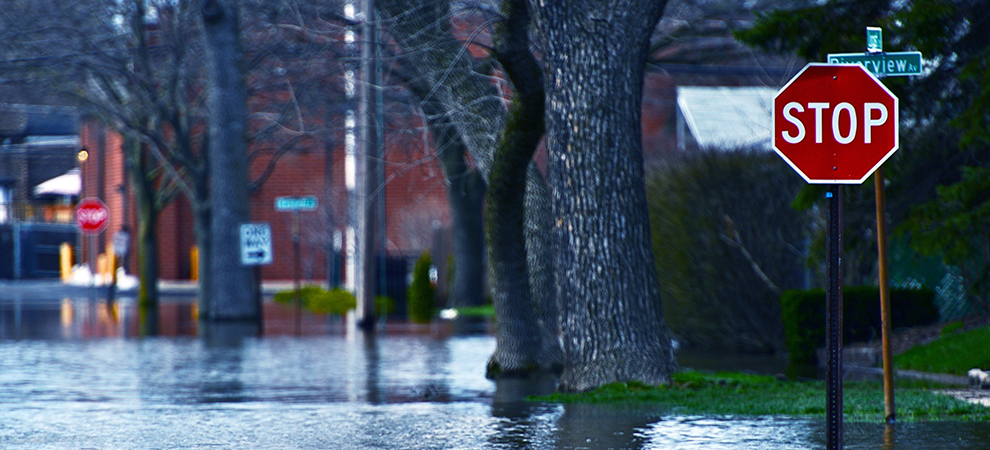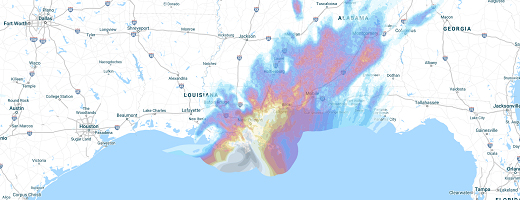The WPJ
THE WORLD PROPERTY JOURNALReal Estate Facts Not Fiction
Residential Real Estate News

Hurricane Zeta Generates Over to $2.5 Billion of Property Damage in Gulf Coast States
Residential News » New Orleans Edition | By WPJ Staff | November 4, 2020 8:10 AM ET
According to new CoreLogic data analysis, insured wind losses for residential and commercial properties in Louisiana, Mississippi and Alabama from Hurricane Zeta are estimated to be between $2.2 billion and $3.5 billion. Insured storm surge losses are estimated to be an additional $0.3 billion to $0.5 billion.
Hurricane Zeta made landfall near Cocodrie, Louisiana, in Terrebonne Parish before directly hitting New Orleans on Wednesday evening, October 28. The storm was a strong Category 2 hurricane with a maximum sustained surface wind speed of 110 miles per hour, just 1 mile per hour below Category 3 intensity. This marks the third hurricane in two months to make landfall in Louisiana. As Hurricane Zeta approached the Louisiana coastline, the storm passed through an area of warm water temperatures and low wind shear, enabling it to strengthen considerably. The storm resulted in at least six deaths and hundreds of downed trees and power lines. A 9-foot surge was measured in the Bay of St. Louis, Mississippi.
"With one month to go, this hurricane season has been incredibly destructive due to the consistent cadence of storms and their too-similar landfall paths. While southwestern Louisiana was largely spared from Hurricane Zeta, New Orleans fell directly in the storm's quick-moving path," said Curtis McDonald, meteorologist and senior product manager of CoreLogic. "The important thing right now is to restore power to the millions of homes in the southeastern states, continue damage repairs in previously impacted homes and prepare for what could be record-breaking hurricane activity in November."
The analysis includes residential homes and commercial properties, including contents and business interruption and does not include broader economic loss from the storm. The table below shows the estimates for commercial and residential insured property losses by state.
After leaving Louisiana late Wednesday night, Hurricane Zeta charged east, upending roofs and extinguishing power to millions of homes across Mississippi, Alabama and Georgia. As the storm moved across the southeastern states, it weakened to a tropical storm centered east of Asheville, North Carolina, by dawn on Thursday. While Zeta did produce some rain, widespread inland flooding was not reported due to the storm's high forward speed. Most of the damage reported was attributed to wind and storm surge. The storm moved offshore from Delaware on October 29 and continues to move eastward over the Atlantic Ocean.
"Natural disasters are increasing in frequency and severity across the board," said Tom Larsen, principal, insurance solutions at CoreLogic. "Sophisticated catastrophe modeling estimates the impact of natural disasters with greater certainty, a key solution to addressing underinsurance issues and risk mitigation. It is imperative for mortgage lenders and insurance carriers to begin leveraging technology to better protect homeowners, accelerate local economic recovery and protect their business."

Sign Up Free | The WPJ Weekly Newsletter
Relevant real estate news.
Actionable market intelligence.
Right to your inbox every week.
Real Estate Listings Showcase
Related News Stories
Residential Real Estate Headlines
- Las Vegas Area Home Prices Uptick 4.3 Percent Annually in March
- Single-Family Rent Growth in U.S. Trends Upward in 2025
- U.S. Mortgage Rates Tick Down Post Trump Tariffs Commencement
- President Trump's 'Liberation Day' Tariffs Potential Impact on the U.S. Housing and Mortgage Markets
- Baby Boomers Biggest Cohort of U.S. Home Buyers in 2025 as Millennials Decline
- U.S. Monthly Housing Payments Hit Record High in 2025
- U.S. Pending Home Sales Uptick in February
- Global Prime Residential Rent Slowdown Continued in Late 2024
- Ireland Home Price Inflation Hits 8 Year High in Early 2025
- Existing Home Sales in America Uptick in February
- Great Miami Area Residential Sales Decline 15 Percent Annually in February
- Mortgage Rates Uptick in Mid-March, Ending 9-Week Decline in U.S.
- World Property Ventures Builds the Future of Real Estate with New Funding Round
- U.S. Builder Sentiment Declines Amid Economic Uncertainty and Rising Costs
- Black Homeownership Rates in U.S. Enjoy Largest Annual Increase of All Racial Groups
- Wealthy Renters Are Taking Over More of the U.S. Rental Market
- If U.S. Congress Does Not Extend NFIP Soon, Thousands of Daily Home Closings Impacted
- U.S. Mortgage Applications Spike 11 Percent in Early March
- Greater Palm Beach Area Residential Sales Rise in Early 2025
- New Apartments in U.S. Are Leasing at Slowest Pace on Record
- U.S. Mortgage Rates Drop to 4 Month Low in March
- Overall U.S. Mortgage Delinquency Rates Dip in December
- New Tariffs on Canada, Mexico to Impact U.S. Homebuilder Input Costs
- Monaco's Property Market: A Tale of Two Cities
- U.S. Home Purchase Cancellations Surge, 1 in 7 Sales Getting Canceled
- U.S. Pending Home Sales Hit Historic Low in Early 2025
- Greater Miami Area Residential Sales Dip in January
- Governor DeSantis Supports Ending Property Taxes in Florida
- WPV Aims to Become the Berkshire Hathaway of Real Estate Tech
- U.S. Home Sales Slump Continues in January
- Average Americans Spend 38 Percent of Monthly Income on Mortgage Payments
- Switzerland's Safe-Haven Appeal Grows with World's Wealthy Homebuyers
- U.S. Builder Confidence Rapidly Declines in February
- Las Vegas Home Sales Rise 6.7 Percent Annually in January, Condo Sales Dip
- Homebuyer Demand in America Drops to 5-Year Low in Early 2025
- Ownership More Affordable Than Renting in Most U.S. Markets
- The World's First Global Listings Service Launches, Called a GLS
- Home Prices Continue to Rise in 89 Percent of U.S. Metros in Late 2024
- Global Luxury Residential Prices Showed Gradual Improvement in Late 2024
- U.S. Construction Hiring Rate Drops to Lowest Levels in 5 Years
Reader Poll
Marketplace Links
This website uses cookies to improve user experience. By using our website you consent in accordance with our Cookie Policy. Read More





